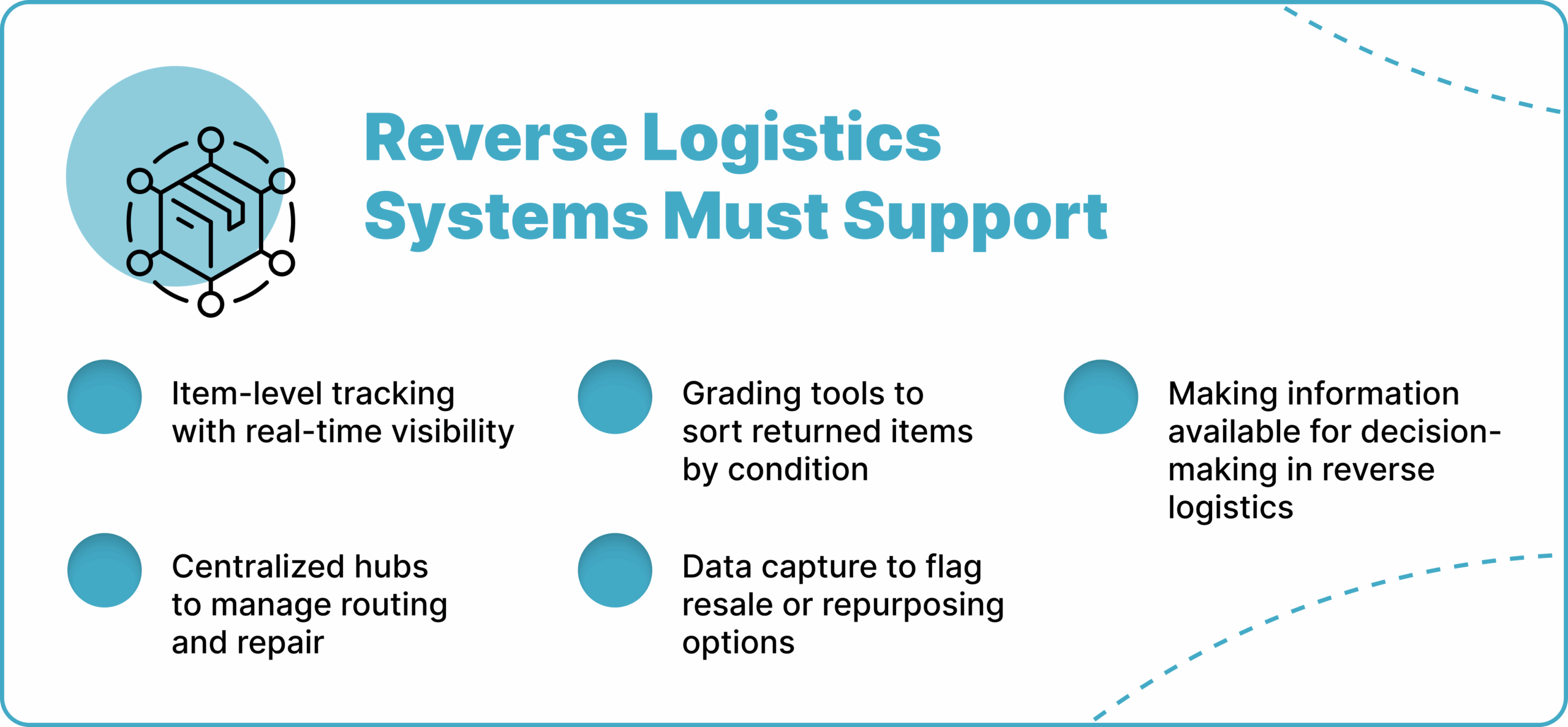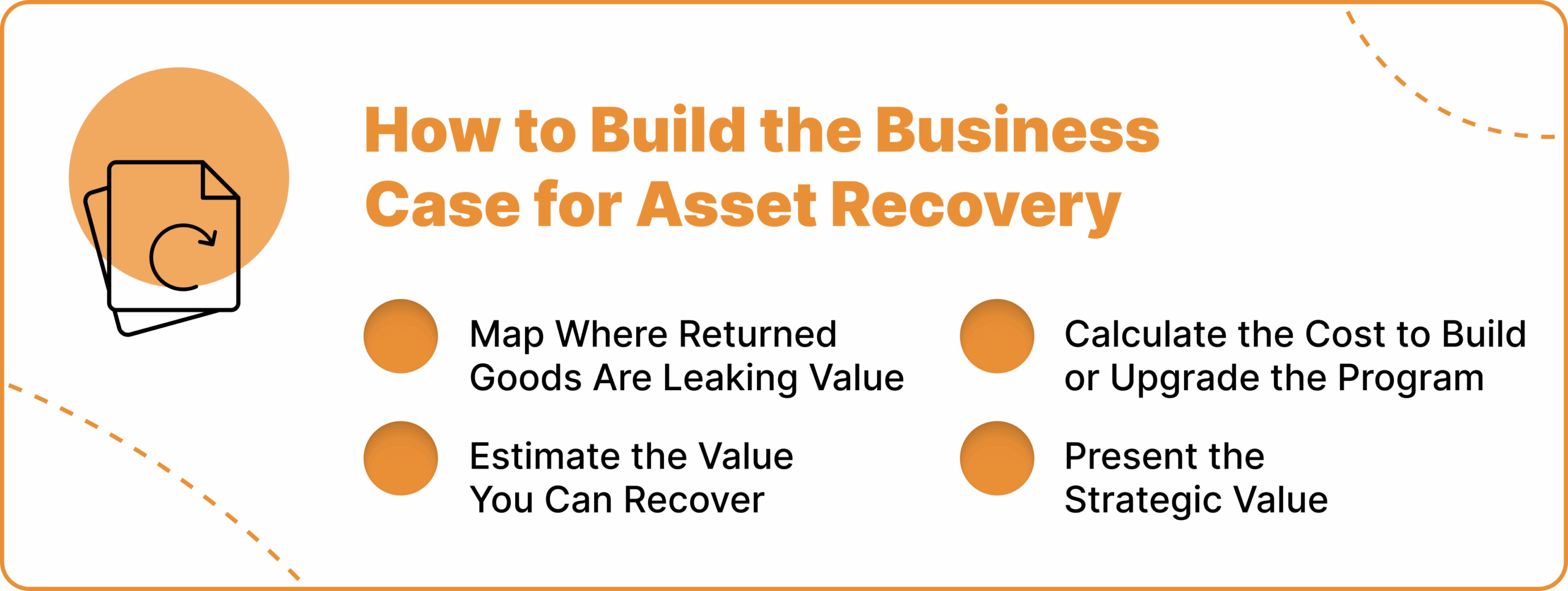The Business Case for Asset Recovery in Reverse Logistics

Asset recovery isn’t a new phenomenon. However, many manufacturers still view returns as a loss, which means they often treat the entire process as a waste rather than a profit lever. But savvy ones treat them as inventory. That’s the shift business leaders must make. For every 3-4 products moving forward through your supply chain, there’s one coming back.
Companies face significant challenges in reverse logistics, including managing returns, waste, and complex supply chain processes. These challenges can impact efficiency, cost, and sustainability efforts.
When these returned goods, whether unused, damaged, unwanted, or aging, are overlooked, mishandled, or discarded, the result is a threefold problem: lost value, lost money, and missed opportunity. To improve efficiency and maximize value recovery, companies must address these logistical challenges effectively. If done correctly, though, asset recovery can turn reverse logistics into a high-yield recovery channel.
This article justifies investments in asset recovery programs using real-world numbers, particularly in sectors such as electronics and industrial equipment, where each return remains valuable.
Asset Recovery: Not Waste — Value in Reverse
A UPS-commissioned study notes that high-tech companies, for example, recover on average 28% of the initial value of returned assets. This indicates that the potential for losses is significant if asset recovery is ineffective. Asset recovery is a process that maximizes the value of returned items.
Improving efficiency in asset recovery processes not only streamlines operations but also leads to better financial outcomes for companies by reducing costs and increasing the value recovered from returned assets.
Typically, it includes refurbishing, reselling, repairing, or reusing equipment, tools, or electronics that would otherwise be scrapped. But the ultimate goal of this process is to recover value, not just recycle or dispose of materials. Understanding this changes how manufacturers and retailers can approach returned products and what they see when they open a returned order.
Well-designed supply chains can better support asset recovery and sustainability goals by being adaptable and responsive to reverse logistics requirements. According to the U.S. Reverse Logistics Association, companies lose over billions annually by failing to recover usable assets in the United States alone. A recovered product doesn’t just save landfill space, it reduces the need for new materials for replacements, lowers environmental impact, and avoids downtime.
Reverse Logistics: The Engine Behind Asset Recovery
Without strong reverse logistics processes, asset recovery will remain out of reach. Reverse logistics management matters as companies cannot recover what they can’t track. If your team doesn’t know where an item is, how it’s moving, what condition it’s in, or what it can be used for, they can’t extract residual value.

Reverse logistics systems must support:
- Item-level tracking with real-time visibility
- Centralized hubs to manage routing and repair
- Grading tools to sort returned items by condition
- Data capture to flag resale or repurposing options
- Making information available for decision-making in reverse logistics
For example, consider a medical device company that builds a centralized triage center to handle equipment returns. They can reduce waste significantly by recovering millions of dollars in resale-ready parts. However, that success begins with a system that makes every return visible, from intake to redeployment. Having available information at each stage is crucial to optimize the recovery process and ensure efficient operations.
Where Asset Recovery Pays Off: Breaking Down ROI
The business case for asset recovery starts with numbers. Your CFO doesn’t need another green initiative. What they need is cost savings, new revenue, or fewer write-offs. Asset recovery can deliver those. Companies can also negotiate the amount recovered from returned assets, sometimes settling for less than the original value to maximize financial returns.
Take an electronics distributor that re-engineers its asset recovery system for example. Within a year, the distributor can significantly reduce annual write-offs by focusing on ensuring better data on return conditions and faster grading.
Return categories with high asset value:
- Channel returns from overstock or failed delivery
- End-of-life units are no longer sold but are still usable
- Warranty returns that are functional or easily repaired
- Internal equipment that’s out of cycle but in demand elsewhere
Note: Each return should be tracked with a unique number, such as an RGA or lot number, to ensure proper processing and credit issuance.
ROI Levers:
- Tax credits from donations or reuses
- Refurbished resale to secondary markets
- Internal redeployment to reduce new buys
- Spare parts harvesting to support service contracts
- Avoided disposal costs (landfill fees, transport, regulatory fines)
Real-World ROI from Electronics and Equipment Industries
Industries that rely on durable goods gain the most from asset recovery. Different industries, such as beverage, construction, and food, approach asset recovery and reverse logistics in unique ways, tailoring their processes to fit specific operational needs and sustainability goals.
Efficient collection of returned, discarded, or end-of-life products is crucial for maximizing ROI in asset recovery programs. Proper collection ensures that valuable materials are gathered from customers or supply chain points for reuse, recycling, or responsible disposal.
Transportation also plays a key role in asset recovery by managing the movement of returned goods. Coordinating shipping loads and planning inbound and outbound logistics are essential for ensuring that products are efficiently returned and processed within the reverse logistics framework.
Electronics (Consumer and Enterprise)
Electronics have short product cycles. But a “returned” tablet may still have market value.
For instance, a PC brand that builds internal grading systems for returned laptops can capture more resale value per device on average by integrating secure data wiping and repair, which boosts customer trust and recovery rate. It is also important to track each returned device with a unique number, such as a lot number or RGA number, to ensure proper processing and accurate tracking throughout the return and resale process.
Returned electronics often sit in warehouses, but those products lose value by the hour. With the right process, the company can recover fast, repackage, and resell with a margin.
Industrial Equipment
Tool rental and construction brands face high asset churn. Yet many still discard used gear without an appropriate review. However, it is crucial to process returns before they are past due for refurbishment or redeployment to maximize asset value. But a manufacturer that launches a refurbishment program for field diagnostics tools, for example, can recover more of each asset’s original cost in any given period.
Spare parts from failed units can support regional service teams. But the key is in repair tracking. That way, the manufacturer can integrate data systems that let technicians flag components for reuse. No paper forms, no guesswork.
Telecom and IT
Telecom companies often replace routers and modems after contract expiration. But imagine a scenario where these devices are rerouted to certified wipe-and-resell centers. The annual savings could be in the millions, and the company will also significantly cut e-waste disposal costs.
Internal reuse is another benefit. Recovered units can go to small-business customers, saving the cost of new shipments. Working systems ensure efficient redeployment of recovered units, maximizing asset recovery and operational efficiency.
How to Build the Business Case for Asset Recovery

Asset recovery doesn’t succeed on goals — it succeeds on metrics. So, to win buy-in from finance or operations teams, you need a clear plan. There is a wealth of data available to support asset recovery planning, helping you identify opportunities and optimize your approach.
The steps below show how to measure and pitch the investment, including identifying return types, value levers, and potential cost savings.
1. Map Where Returned Goods Are Leaking Value
- Identify return categories: warranty, undelivered, damaged
- Audit time to recovery, processing cost, and end disposition
- Track how many items go to the landfill or long-term storage
2. Estimate the Value You Can Recover
- Benchmark resale or reuse value per product type
- Include disposal avoidance, tax write-offs, and internal redeployment
- Show what portion of your supply chain can be served with recovered assets
3. Calculate the Cost to Build or Upgrade the Program
- Identify technology needs (e.g., ReverseLogix)
- Estimate the break-even point and payback time
- Include staffing, training, software, and repair tools
4. Present the Strategic Value
- Highlight sustainability goals, but tie them to cost
- Link the recovery program to inventory agility and customer satisfaction
- Show how asset recovery reduces the need for new materials and lowers the risk of delay
Every business has products that could be reused. With better tools and better tracking, the return can be just as valuable as the first sale.
Why You Can’t Treat Asset Recovery Like a Side Project
Asset recovery must be part of your main supply chain, not a sideline. However, too many companies put it under customer service or warranty. But returned goods need the same speed, data, and control as outbound shipments.
Returns carry real weight:
- They cost money when ignored
- They help manage inventory when reused
- They deliver environmental gains without adding cost
- They shorten cycle time for replacements and field repairs
The most effective asset recovery programs work because they are built into the operations process. Not tacked on. Not buried. Not optional.
Every Return Is an Asset — If You Treat It Like One
Returned items are not waste. They’re part of your value chain. Asset recovery is a practical measure that reduces costs and enhances agility. But it doesn’t start in the warehouse — it starts in how you think. Manufacturers and retailers who want to improve profits and reduce environmental damage must act.
Efficient repair management is crucial for saving money and maintaining customer satisfaction. With the right system, you can resolve issues quickly and maximize the value of returned products. This is why ReverseLogix is essential for businesses handling electronics & high-tech products. Watch demo to see how ReverseLogix can improve your returns process and build customer loyalty.

Frequently Asked Questions
Sustainable packaging plays a major role in protecting returned products during reverse transit. Poor packaging leads to damage, which reduces the chance of value recovery. Companies that design reusable or modular packaging improve return condition, lower repair needs, and help maintain resale value. This is especially useful in equipment-heavy and electronics industries, where surface damage can cause a unit to fail inspection.
Yes. Leading retailers now connect online return portals with customer profiles and credit systems. This helps determine refund or store credit eligibility based on return condition and item resale potential. When built into the policy, this approach rewards behavior that supports sustainability, like sending back items with original packaging or within short return windows. It also helps the company assess recovery value faster.
The best starting point is to segment return reasons and sort by material type, age, and resale demand. Tools that scan serial numbers or component lists can flag which materials can be resold or repurposed. Some businesses use AI tools to determine future value based on item condition and market history. Prioritizing items with short refurbishment times and high resale prices can make the recovery process more efficient.
When delivery fails or returned goods arrive damaged, a few key steps improve recovery:
Document the item’s condition with photos at arrival
Sort items by repair potential vs. recycling needs
Use automated triage tools to reduce human error
Follow documented practices for cleaning, repackaging, and routing
These steps help move items back into circulation or toward secondary markets. A strong recovery program ensures each failed delivery still holds measurable value for the company.
